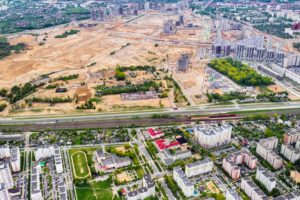The Indian real estate landscape is experiencing unprecedented transformation in 2025, with market dynamics shifting toward sustainable growth and emerging opportunities. The Indian real estate market size reached USD 482 billion in 2024 and is projected to reach USD 1,184 billion by 2033, growing at a CAGR of 10.50%. This remarkable growth trajectory positions the Indian real estate market as one of the most promising investment destinations globally.
Table of Contents
Understanding these evolving trends is crucial for investors, homebuyers, and industry stakeholders navigating today’s complex market environment. The convergence of technology, policy reforms, and changing consumer preferences is reshaping how we perceive and interact with real estate across India.
Key Drivers Fueling the 2025 Latest Indian Real Estate Market
Economic Stability and Policy Support
The Indian Real Estate Industry is benefiting from robust economic fundamentals and supportive government policies. Interest rates on home loans offered by major banks remain stable at about 8-11%, with recent policy cuts expected to benefit potential homebuyers. This favorable lending environment is particularly advantageous for first-time buyers and affordable housing segments.
Urbanization and Infrastructure Development
Rapid urbanization, increasing disposable incomes, and rising demand for residential and commercial properties are driving the Indian real estate market. Government initiatives in infrastructure development, including smart cities and transportation corridors, are creating new investment hotspots across tier-2 and tier-3 cities.
Technology Integration and PropTech Revolution
Digital transformation is revolutionizing property transactions, with virtual tours, AI-powered valuations, and blockchain-based documentation becoming mainstream. These technological advancements are improving transparency and efficiency in the Indian real estate market.
To gauge a property’s real value beyond advertised square footage, you can use our easy Carpet Area Calculator for precise estimates.”
Regional Market Insights and Emerging Trends
Suburban Growth and Integrated Townships
The shift from major urban centers toward suburban areas represents a new era of residential living. Integrated townships offering comprehensive amenities are gaining popularity among homebuyers seeking balanced lifestyles away from congested city centers.
Luxury Housing Segment Expansion
The demand for luxury home projects in India, particularly those priced at Rs. 4 crore and above, saw a remarkable surge in 2024. This trend continues into 2025, driven by high-net-worth individuals seeking premium properties with world-class amenities.
Commercial Real Estate Evolution
The commercial segment is witnessing significant transformation with real estate demand for data centers expected to increase by 15-18 million sq. ft. by 2025. Co-working spaces, flexible office solutions, and mixed-use developments are reshaping commercial property landscapes.
As developers chase more space-efficient layouts and premium amenities, the luxury sector is evolving fast. Explore what’s next with our analysis of the future of luxury real estate in India
Investment Opportunities and Buyer Preferences in 2025
Affordable Housing Momentum
Developers are concentrating on creating small, affordable homes in suburban locations that appeal to middle-class families and first-time purchasers. Government schemes like Pradhan Mantri Awas Yojana continue supporting this segment’s growth.
Sustainable and Green Building Focus
Environmental consciousness is driving demand for eco-friendly properties. Green buildings are among the key real estate trends to watch in India for 2025. Developers incorporating sustainable features are attracting environmentally aware buyers willing to pay premium prices.
NRI Investment Surge
Rising NRI investments represent a significant trend in the Indian real estate market for 2025. Simplified investment procedures and attractive returns are encouraging overseas Indians to invest in domestic properties.
Sector-Specific Growth Patterns
Residential Real Estate Dominance
Residential real estate dominates with a projected market volume of $40.20 trillion in 2025. This segment’s strength reflects sustained housing demand across income categories and geographic regions.
Commercial and Retail Segments
Office spaces are adapting to hybrid work models, while retail real estate is evolving with experiential shopping concepts. Mixed-use developments combining residential, commercial, and retail components are gaining investor interest.
FSI (Floor Space Index) remains a pivotal factor in understanding the pace and scale of development across cities—learn more with our detailed guide to FSI meaning & calculation.
Future Outlook and Market Predictions
Growth Trajectory and Market Expansion
The sector is set to grow at 9.2% CAGR, supported by a strong economy and low lending rates. This consistent growth pattern indicates sustained investor confidence and market resilience.
Technology-Driven Innovation
PropTech innovations will continue reshaping property transactions, with artificial intelligence, virtual reality, and blockchain technologies becoming integral to real estate operations. These advancements will enhance transparency, reduce transaction costs, and improve customer experiences.
Regional Development Patterns
Tier-2 and tier-3 cities are emerging as significant growth centers, offering affordable property options and improved infrastructure. This geographic diversification reduces market concentration risks while creating new investment opportunities.
Strategic Considerations for Market Participants
Industry leaders like Ganga Realty are positioning themselves to capitalize on these emerging trends by focusing on sustainable development practices, innovative design solutions, and customer-centric approaches. Their expertise in understanding local market dynamics while maintaining high construction standards exemplifies how established developers are adapting to evolving market conditions.
The integration of smart home technologies, energy-efficient systems, and community-focused amenities reflects changing buyer preferences toward comprehensive lifestyle solutions rather than mere accommodation.
Also Read : Commercial Real Estate Investment: Trends, Risks & Opportunities
Conclusion
The Indian real estate market in 2025 presents compelling opportunities across residential, commercial, and emerging sectors. With robust growth projections and favorable economic conditions, the Indian real estate news consistently highlights positive market sentiment and investor confidence. Success in this dynamic environment requires understanding regional variations, embracing technological innovations, and aligning with sustainability trends.
With growing emphasis on compliance, understanding your rights under RERA is essential—especially regarding carpet area disclosures. Check out our full breakdown on RERA carpet area definitions and how to calculate them.
The Indian Real Estate Industry continues evolving, offering diverse investment options for stakeholders seeking long-term value creation in one of the world’s fastest-growing property markets.
Frequently Asked Questions (FAQs)
How do rental yields in Gurgaon compare to other major Indian cities?
Gurgaon’s commercial rental yields of 6-10% per annum are among the highest in India, particularly for Grade-A office spaces. Areas like Sector 81 offer rental returns of 15.3%, while established locations like Cyber City and Golf Course Road provide stable 8-10% yields, outperforming most residential investments and traditional financial instruments.
What are the typical costs involved in buying office space in Gurgaon?
Office space costs vary by location, with premium areas like Cyber City commanding ₹150-200 per sqft monthly rental rates, while emerging sectors offer rates from ₹80-150 per sqft. Purchase prices depend on location, amenities, and project quality. Additional costs include registration fees, maintenance charges, and fit-out expenses, which should be factored into investment calculations.
Which sectors in Gurgaon offer the best investment potential for startups?
Sector 81 leads with 15.3% rental returns, followed by Sushant Lok Phase 1 (14.4%) and Sector 102 (12.3%). Established areas like Cyber City, Golf Course Road, and MG Road offer stable high returns with premium amenities. New Gurugram and Dwarka Expressway show impressive capital appreciation of 30-37% year-on-year growth.
How does buying office space compare to leasing for startups?
Buying office space provides long-term cost savings, asset building, and rental income potential from unused space. While leasing offers flexibility, purchasing eliminates rent escalations and provides tax benefits through depreciation. For startups with stable funding and growth plans, buying often proves more economical over 5-7 years.
What infrastructure advantages does Gurgaon offer for technology startups?
Gurgaon provides world-class digital infrastructure including high-speed fiber internet, reliable power supply with backup systems, advanced telecommunications, and proximity to data centers. The city offers green building certifications, energy-efficient designs, and modern co-working solutions specifically designed for technology companies and startups.
Are there financing options available for startups looking to buy office space?
Yes, several financing options exist including traditional commercial loans, developer financing schemes, lease-to-own arrangements, and partnership models. Many banks offer specialized commercial real estate loans for startups with reasonable down payments. Some developers also provide innovative financing structures that allow gradual ownership transition.
How does Gurgaon’s startup ecosystem support business growth?
With over 724 active startups and ranking 8th in India for startup activity, Gurgaon offers extensive networking opportunities, talent pool access, and potential partnerships. The city hosts major accelerators, incubators, and investors, while proximity to multinational corporations provides B2B opportunities and enterprise client access.
What are the long-term appreciation prospects for commercial real estate in Gurgaon?
Recent market data shows impressive capital appreciation rates of 30-37% in key areas like New Gurugram and Dwarka Expressway. Ongoing infrastructure projects, metro expansions, and continued corporate presence suggest sustained growth. The city’s strategic location and business-friendly policies support long-term value appreciation.
How do luxury residential projects and high-rise apartments in Gurgaon compare as investment alternatives?
While luxury residential projects in Gurgaon and high-rise apartments offer lifestyle benefits, commercial office space provides superior financial returns with 6-10% rental yields versus 3-5% for residential properties. Commercial real estate also offers better depreciation benefits, tax advantages, and appreciation potential, making it more attractive for business owners seeking both operational space and investment returns.





